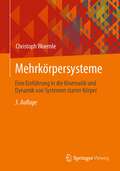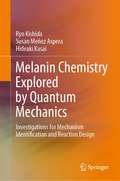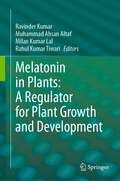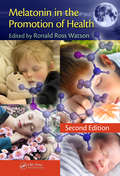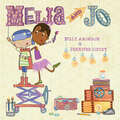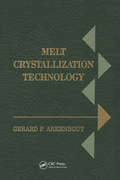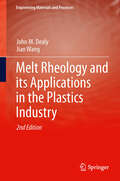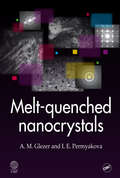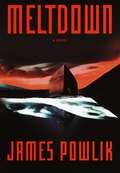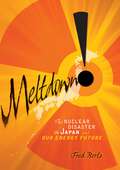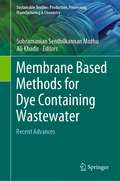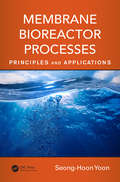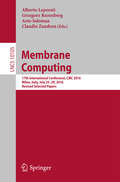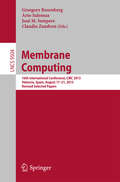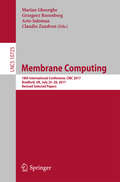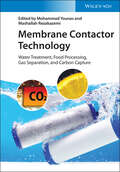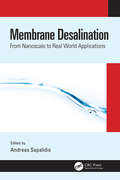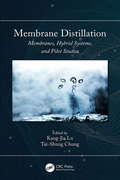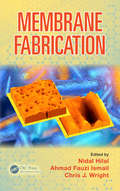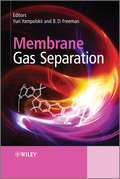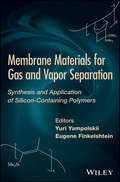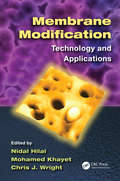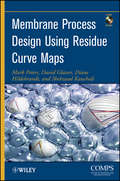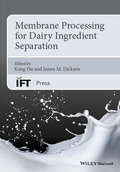- Table View
- List View
Mehrkörpersysteme: Eine Einführung in die Kinematik und Dynamik von Systemen starrer Körper
by Christoph WoernleDas Buch Mehrkörpersysteme führt den Leser von den Grundlagen der Technischen Mechanik zu den für die rechnergestützte Erstellung geeigneten Formulierungen der kinematischen und dynamischen Gleichungen von Systemen starrer Körper. Mehrkörpersysteme werden für die numerische Simulation komplexer mechanischer Systeme im Maschinenbau, der Fahrzeugtechnik, der Luft- und Raumfahrttechnik und der Biomechanik eingesetzt. Im Mittelpunkt der Darstellung stehen die impliziten und expliziten mathematischen Formulierungen der Bindungen, welche die Bewegung der Teilkörper geometrisch beschränken und die Richtungen der Reaktionskräfte und Reaktionsmomente definieren. Daraus ergibt sich eine durchgängige und gemeinsame Betrachtungsweise für die verschiedenen bekannten Formen der Bewegungsgleichungen von Mehrkörpersystemen. Neben offenen Mehrkörpersystemen mit Baumstruktur werden auch geschlossene Mehrkörpersysteme mit kinematischen Schleifen ausführlich behandelt. In der dritten Auflage sind die ebenen Mehrkörpersysteme in einem eigenen Kapitel dargestellt, um den Übergang von den Massenpunktsystemen zu den räumlichen Mehrkörpersystemen zu erleichtern.
Melanin Chemistry Explored by Quantum Mechanics: Investigations for Mechanism Identification and Reaction Design
by Hideaki Kasai Ryo Kishida Susan Meñez AsperaThis book discusses recent advances in theoretical–computational studies on the biosynthesis of melanin pigment (melanogenesis). These advances are being driven by the development of high-performance computers, new experimental findings, and extensive work on medical applications involving the control of pigmentation and the treatment of challenging dermatological diseases. Understanding the elementary processes involved in chemical reactions at the atomic scale is important in biochemical reaction design for effective control of the pigmentary system. Accordingly, the book focuses on the elementary steps involved in melanogenesis, which crucially affect the composition of the resulting melanin pigment by means of competitive reactions. The book also addresses reactions analogous to melanogenesis, with a focus on o-quinone reactions, which are especially important for understanding melanogenesis-associated cytotoxicity.
Melatonin in Plants: A Regulator for Plant Growth and Development
by Ravinder Kumar Muhammad Ahsan Altaf Milan Kumar Lal Rahul Kumar TiwariThis book highlights the multifunctional role of the ubiquitous molecule, melatonin, in crop plants. The major focus of this edition is to provide detailed insights into morphophysiological, biochemical, and molecular responses of melatonin in the growth and development of the plant. The inception of melatonin as an animal hormone and the subsequent discovery of its multifaceted function in the animal system has triggered the research on this pineal gland hormone. During the last decade, the discovery, quantification and functional studies of melatonin as phytohormone has emerged at a rapid pace. Recently, this phyto-protectant has become an integral component of lab and field-based research on the mitigation of adverse effects of climate-driven abiotic stresses and postharvest biology and technology.The book explores various biosynthetic pathways and detection of melatonin covering its role in flowering, fruit development, photosynthesis, respiration, hormonal crosstalk, post-harvest biology and reactive oxygen species and nitrogen cycles. This book is of high interest to postharvest industries, horticulturists, scientists, researchers, and students.
Melatonin in the Promotion of Health
by Ronald Ross WatsonMelatonin is a powerful hormone and antioxidant with numerous effects on the metabolism and the health of humans. This volume provides a wide variety of expert reviews on the biology of melatonin relevant to health. Beginning with a history of melatonin and its relation to circadian rhythms, the book examines its use in a host of applications, including gastrointestinal diseases, anesthesia and surgery, bone health, breast cancer, cardiovascular diseases, diabetes, and age-related macular degeneration and uveitis. It also examines applications related to melanoma, solar skin damage, collagen synthesis, the prevention of DNA damage, mental disorders, sleep, and issues related to jet lag and shift work.
Melia and Jo
by Billy AronsonMelia and Jo will be to STEAM what Rosie Revere is to STEM. Melia is scientific and loves to create things in her backyard laboratory, but something is missing. Her inventions just aren&’t quite right. Enter Jo, her new friend with an artistic spirit. When you add the arts to sciences, something magical happens! This whimsically illustrated picture book is the perfect introduction to the benefits of STEAM-focused curriculum.
Melt Crystallization Technology
by Tine Arkenbout-de VroomeFrom the Author's Preface: There is a growing demand for ultrapure organic compounds such as fine chemicals, pharmaceuticals, and basic materials for use in the polymer industry. . . . In quite a number of cases, it is difficult or impossible to manufacture ultrapure organics efficiently using conventional separation techniques such as distillation. Moreover, conventional techniques usually require large amounts of energy. To improve the purification efficiency of organics, special techniques based on crystallization from the melt have been developed. Melt crystallization meets industry's need for a highly selective separation process for organic compounds which operates at low enough temperatures to prevent thermal degradation. Melt crystallization processes have the added advantage that they are energy-efficient and ecologically sound. Melt crystallization techniques appear to be particularly promising for upgrading organic materials and are one of the few routes that appear to be feasible for purifying starter materials for high-tech polymers. The aim of this book is to provide basic information on melt crystallization technology. . . . This monograph consists of three parts: 1. basic principles, 2. process options, and 3. technical equipment and applicability. This new book is the first unified guide and reference to an important chemical process technology. It is comprehensive and organized for easy reference. More than 150 diagrammatic representations, flow charts and photographs illustrate equipment and processes. More than 40 tables provide useful reference data.
Melt Rheology and its Applications in the Plastics Industry
by Jian Wang John M DealyThis is the second edition of Melt Rheology and its Role in Plastics Processing, although the title has changed to reflect its broadened scope. Advances in the recent years in rheometer technology and polymer science have greatly enhanced the usefulness of rheology in the plastics industry. It is now possible to design polymers having specific molecular structures and to predict the flow properties of melts having those structures. In addition, rheological properties now provide more precise information about molecular structure. This book provides all the information that is needed for the intelligent application of rheology in the development of new polymers, the determination of molecular structure and the correlation of processability with laboratory test data. Theory and equations are limited to what is essential for the use of rheology in the characterization of polymers, the development of new plastics materials and the prediction of plastics processing behavior. The emphasis is on information that will be of direct use to practitioners. Extensive references are provided for those wishing to pursue certain issues in greater depth. While the primary audience is applied polymer scientists and plastics engineers, the book will also be of use to postgraduate students in polymer science and engineering and as a text for a graduate course.
Melt-Quenched Nanocrystals
by A. M. Glezer I. E. PermyakovaMelt quenching-the method of quenching from the liquid state-provides new opportunities for producing advanced materials with a unique combination of properties. In the process of melt quenching, attainment of critical cooling rates can produce specific structural states of the material. Nanocrystalline materials produced by melt quenching are clas
Meltdown
by James PowlikA DEADLY SECRET LIES BURIED BENEATH THE WORLD'S LAST FRONTIER Dr. Carol Harmon has taken her research vessel, the Phoenix, deep into one of the most forbidding places in the world, the ceaselessly shifting Arctic icescape. In one frightening moment, everything goes very wrong. During a routine dive, two of her crew are ravaged by what appears to be radiation poisoning. Knowing she needs help fast, Carol calls on the person she trusts most, a man leading his own expedition on the opposite pole of the globe. Brock Garner is an oceanographer, a former Naval officer, and a man who has never quite stopped loving his ex-wife, Carol. By the time Garner arrives, a frightening scenario is taking shape: Deep beneath the ice, something is leaking deadly radiation. Worse yet, it may be only part of a bigger cataclysm. A disaster of untold proportions is looming-the world's first man-made Ice Age. A life-and-death battle is about to be unleashed...not just for the Arctic, but for the very future of Earth.
Meltdown!: The Nuclear Disaster in Japan and Our Energy Future (Single Titles Ser.)
by Fred BortzJapan. March 11, 2011. 2:46 P.M. The biggest earthquake in Japan's history—and one of the world's five most powerful since 1900—devastated the Tohoku region, 320 kilometers (200 miles) northeast of Tokyo. It triggered a huge tsunami that left crippling damage in its wake. More than 13,000 people drowned, and thousands of buildings and homes were reduced to rubble. As people assessed the damage, they made the most frightening discovery of all: the Fukushima #1 nuclear power plant was seriously damaged and three of its six reactors were heading for meltdowns. Workers tried desperately—but unsuccessfully—to save them. Explosions and fires released radioactivity into the air. Within days the Japanese government declared a 20-kilometer (12-mile) evacuation zone. The future of the plant, the long-term health of those exposed to radiation, and the effects on the environment remained uncertain. Learn more about this massive catastrophe as Dr. Fred Bortz examines both the human tragedy and the scientific implications of the nuclear meltdown. Compare this disaster to similar nuclear events in the United States and in Ukraine, and move ahead with Dr. Bortz as he explores the global debate about the future of nuclear power and alternative sources of energy.
Membrane Based Methods for Dye Containing Wastewater: Recent Advances (Sustainable Textiles: Production, Processing, Manufacturing & Chemistry)
by Subramanian Senthilkannan Muthu Ali KhadirThis book highlights recent findings of membrane - based dye removal methods along with the application of photocatalytic, nanofiltration and ultrafiltration membrane including membrane – based fibers, metal-organic frameworks, polyethersulfone, ceramic, etc. Among water and wastewater pollutants, dyes have been normally observed and detected in various aquatic solutions, including rivers and lakes. Aesthetic pollution, toxicity, persistent, and carcinogenicity are some of the adverse effects of dyes entering the ecosystem. Although dyes have brought a colourful world, their presence in the environment are responsible for adverse effects on the planet. Diverse physical, chemical and biological methods are available to treat dye contaminated water. This book presents membrane separation technology that has been developed in the past decade to treat different wastewaters, and owning to its effective performance, has garnered the attention of academia and industry alike.
Membrane Bioreactor Processes: Principles and Applications (Advances in Water and Wastewater Transport and Treatment)
by Seong-Hoon YoonGrasp the Essential Principles of Membrane Bioreactor ProcessesEvolved from the conventional activated sludge (CAS) process, membrane bioreactor (MBR) processes have become the next-generation solution for municipal and industrial wastewater treatment and recycle. Membrane Bioreactor Processes: Principles and Applications explores nearly all the th
Membrane Computing
by Grzegorz Rozenberg Arto Salomaa Claudio Zandron Alberto LeporatiPart of the broader research field of natural computing, Membrane Computing is an area within computing science that aims to abstract computing ideas and models from the structure and functioning of living cells, as well as from the way the cells are organized in tissues or higher order structures. This handbook provides both a comprehensive survey of available knowledge and established research topics, and a guide to recent developments in the field, covering thesubject from theory to applications. The handbook is suitable both for introducing novices to this area of research, and as a main source of reference for active researchers. It sets out the necessary biological and formal background, with the introductory chapter serving as a gentle introduction toand overview of membrane computing. Individual chapters, written by leading researchers in membrane computing, present the state of the art of all main r`search trends and include extensive bibliographies.
Membrane Computing
by Grzegorz Rozenberg José M. Sempere Arto Salomaa Claudio ZandronThis bookconstitutes revised selected papers from the International Conference onMembrane Computing, CMC 2015, held in Valencia, Spain, in August 2015. The 22 fullpapers presented in this volume were carefully reviewed and selected from 34submissions. The volume also contains 3 invited talks in full-paper length.
Membrane Computing
by Grzegorz Rozenberg Arto Salomaa Claudio Zandron Marian GheorghePart of the broader research field of natural computing, Membrane Computing is an area within computing science that aims to abstract computing ideas and models from the structure and functioning of living cells, as well as from the way the cells are organized in tissues or higher orderstructures. It studies models of computation (known as P systems) inspired by the biochemistry of cells, in particular by the role of membranes in the compartmentalization of living cells into "protected reactors". This handbook provides both a comprehensive survey of available knowledge and established research topics, and a guide to recent developments in the field, covering the subject from theory to applications. The handbook is suitable both for introducing novices to this area of research, and as a mainsource of reference for active researchers. It sets out the necessary biological and formal background, with the introductory chapter serving as a gentle introduction to and overview of membrane computing. Individual chapters, written by leading researchers in membrane computing, present the stateof the art of all main research trends and include extensive bibliographies.
Membrane Contactor Technology: Water Treatment, Food Processing, Gas Separation, and Carbon Capture
by Mohammad Younas Mashallah RezakazemiAn eye-opening exploration of membrane contactors from a group of industry leaders In Membrane Contactor Technology: Water Treatment, Food Processing, Gas Separation, and Carbon Capture, an expert team of researchers delivers an up-to-date and insightful explanation of membrane contactor technology, including transport phenomena, design aspects, and diverse process applications. The book also includes explorations of membrane synthesis, process, and module design, as well as rarely discussed process modeling and simulation techniques. The authors discuss the technical and economic aspects of this increasingly important technology and examine the geometry, flow, energy and mass transport, and design aspects of membrane contactor modules. They also cover a wide range of application opportunities for this technology, from the materials sciences to process engineering. Membrane Contactor Technology also includes: A thorough introduction to the membrane contactor extraction process, including dispersion-free membrane extraction processes and supported liquid membrane processes Comprehensive explorations of membrane transport theory, including discussions of diffusional mass and heat transfer modeling, as well as numerical modeling In-depth examinations of module configuration and geometry, including design and flow configuration Practical discussions of modes or operation, including membrane distillation, osmotic evaporation, and forward osmosis Perfect for process engineers, biotechnologists, water chemists, and membrane scientists, Membrane Contactor Technology also belongs in the libraries of chemical engineers, polymer chemists, and chemists working in the environmental industry.
Membrane Desalination: From Nanoscale to Real World Applications
by Andreas SapalidisThis book aims to provide details about membrane desalination processes, starting from basic concepts leading to real world implementation. Chapters cover novel research topics such as biomimetic and nanocomposite membranes, nanostructured fillers for mixed matrix membranes, advanced characterization techniques and molecular modeling. Additionally, engineering and economical aspects of desalination as well as the exploitation of green energy sources are thoroughly presented. This books targets bridging the gap between the everyday research laboratory practices with practical application demands, so that the readers gain a global perspective of all desalination challenges.
Membrane Distillation: Membranes, Hybrid Systems and Pilot Studies
by Kang-Jia Lu Tai-Shung ChungThis book aims to elaborate the basics and recent advances of membrane distillation (MD) as the same shows promise for seawater desalination and wastewater treatment. Starting with fundamentals of MD processes, including the heat and mass transfer analysis, energy evaluation and mathematical modelling, text includes engineering and molecular design of MD membranes. Various types of hybrid systems, including freeze desalination (FD)-MD, MD-crystallization (MDC), pressure retarded osmosis (PRO)-MD and forward osmosis (FO)-MD, will be discussed in this book. Further, it summarizes the future of MD from both industrial and academic perspectives along with energy sources and economic analysis.
Membrane Fabrication
by Ahmad Fauzi Ismail Nidal Hilal Chris J. WrightMembranes play a crucial role in ensuring the optimum use and recovery of materials in manufacturing. In the process industries, they are required for efficient production and minimization of environmental impact. They are also essential for the efficient production of clean water, a significant global issue. Membrane Fabrication brings together ex
Membrane Filtration
by Greg FoleyFocusing on the application of membranes in an engineering context, this hands-on computational guide makes previously challenging problems routine. It formulates problems as systems of equations solved with MATLAB, encouraging active learning through worked examples and end-of-chapter problems. The detailed treatments of dead-end filtration include novel approaches to constant rate filtration and filtration with a centrifugal pump. The discussion of crossflow microfiltration includes the use of kinetic and force balance models. Comprehensive coverage of ultrafiltration and diafiltration processes employs both limiting flux and osmotic pressure models. The effect of fluid viscosity on the mass transfer coefficient is explored in detail, the effects of incomplete rejection on the design and analysis of ultrafiltration and diafiltration are analysed, and quantitative treatments of reverse osmosis and nanofiltration process analysis and design are explored. Includes a chapter dedicated to the modelling of membrane fouling.
Membrane Gas Separation
by Benny Freeman Yuri YampolskiiGas separation membranes offer a number of benefits over other separation technologies, and they play an increasingly important role in reducing the environmental impacts and costs of many industrial processes.This book describes recent and emerging results in membrane gas separation, including highlights of nanoscience and technology, novel polymeric and inorganic membrane materials, new membrane approaches to solve environmental problems e.g. greenhouse gases, aspects of membrane engineering, and recent achievements in industrial gas separation. It includes:Hyperbranched polyimides, amorphous glassy polymers and perfluorinated copolymersNanocomposite (mixed matrix) membranesPolymeric magnetic membranesSequestration of CO2 to reduce global warmingIndustrial applications of gas separationDeveloped from sessions of the most recent International Congress on Membranes and Membrane Processes, Membrane Gas Separation gives a snapshot of the current situation, and presents both fundamental results and applied achievements.
Membrane Materials for Gas and Separation: Synthesis and Application fo Silicon-containing Polymers
by Yuri Yampolskii E. FinkelshteinSi containing polymers have been instrumental in the development of membrane gas separation practices since the early 1970s. Their function is to provide a selective barrier for different molecular species, where selection takes place either on the basis of size or on the basis of physical interactions or both. Combines membrane science, organosilicon chemistry, polymer science, materials science, and physical chemistry Only book to consider polymerization chemistry and synthesis of Si-containing polymers (both glassy and rubbery), and their role as membrane materials Membrane operations present environmental benefits such as reduced waste, and recovered/recycled valuable raw materials that are currently lost to fuel or to flares
Membrane Modification: Technology and Applications
by Nidal Hilal Chris J. Wright Mohamed KhayetMembrane Modification: Technology and Applications is written for engineers, scientists, graduate students, and researchers in the field of membrane science and technology, materials science, applied physics, chemistry, and environmental science. The book presents the complete range of membrane modification techniques used to increase efficiency of
Membrane Process Design Using Residue Curve Maps
by David Glasser Diane Hildebrandt Mark Peters Shehzaad KauchaliDesign and Synthesis of Membrane Separation Processes provides a novel method of design and synthesis for membrane separation. While the main focus of the book is given to gas separation and pervaporation membranes, the theory has been developed in such a way that it is general and valid for any type of membrane. The method, which uses a graphical technique, allows one to calculate and visualize the change in composition of the retentate (non-permeate) phase. This graphical approach is based on Membrane Residue Curve Maps. One of the strengths of this approach is that it is exactly analogous to the method of Residue Curve Maps that has proved so successful in distillation system synthesis and design.
Membrane Processing for Dairy Ingredient Separation (Institute of Food Technologists Series)
by Kang Hu James M. DicksonMembrane processing is a filtration technique in which particles are separated from liquids by being forced through a porous material, or membrane. Applied to dairy products, the separation techniques allow valuable compounds, found in milk, to be isolated for use as ingredients in food processing. A comprehensive overview of membrane separation processes, this book explores various applications such as pressure driven processes, electrical field driven processes, and concentration driven processes, for the recovery of various dairy streams and ingredients. The topics covered place emphasis on new applications, including microfiltration, ultrafiltration, reverse osmosis, electrodialysis, and pervaporation. The text also presents in-depth knowledge of the mechanisms of each membrane separation process, as well as membrane types and the equipment used in these processes. Combining their educational backgrounds and substantial industrial experience in dairy ingredients processes, the authors address cutting-edge technologies that have been thoroughly researched and have great potential to be commercialized in the near future. The book will therefore be of interest to dairy industry professionals and will serve as a source of reference material for professors and students in food science and engineering.
